 W
WBangalore blue grape, also simply called Bangalore Blue, is a variety of fox grape grown in districts around Bangalore in India. It is one of the three major varieties of grape in the state of Karnataka. It received a geographical indication tag from the Government of India in 2013.
 W
WBangalore rose onion, locally called gulabi eerulli, is a variety of onion grown in and around Bangalore in Karnataka. It got the Geographical Indication tag in 2015.
 W
WBidriware is a metal handicraft from Bidar. It was developed in the 14th century C.E. during the rule of the Bahamani Sultans. The term "bidriware" originates from the township of Bidar, which is still the chief centre for the manufacture of the unique metalware. Due to its striking inlay artwork, bidriware is an important export handicraft of India and is prized as a symbol of wealth. The metal used is a blackened alloy of zinc and copper inlaid with thin sheets of pure silver. This native art form has obtained Geographical Indications (GI) registry.
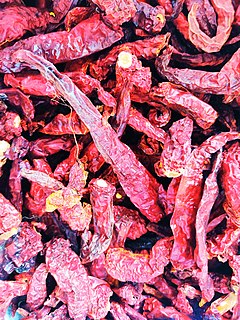 W
WByadgi chilli is a famous variety of chilli mainly grown in the Indian state of Karnataka. It is named after the town of Byadgi which is located in the Haveri district of Karnataka. It is sometimes written as Bedgi in some super markets and grocery stores in India. The business involving Byadagi chillis has the second largest turnover among all chilli varieties of India. An oil, oleoresin extracted from these chillies is used in the preparation of nail polish and lipsticks. Byadagi chilli is also known for its deep red colour and is less spicy and is used in many food preparations of South India. Byadagi chilli has been accorded Geographical Indication (GI) in February 2011. Its GI tag is 129.
 W
WChannapatna toys are a particular form of wooden toys and dolls that are manufactured in the town of Channapatna in the Ramanagara district of Karnataka state, India. This traditional craft is protected as a geographical indication (GI) under the World Trade Organization, administered by the Government of Karnataka. As a result of the popularity of these toys, Channapatna is known as Gombegala Ooru (toy-town) of Karnataka. Traditionally, the work involved lacquering the wood of the Wrightia tinctoria tree, colloquially called Aale mara (ivory-wood).
 W
WCoorg orange, also called Coorg mandarin, is a cultivar of orange from Kodagu in Karnataka. It was given the Geographical Indication status in 2006.
 W
WThe Devanahalli pomelo is a variety of the citrus fruit pomelo of the family Rutaceae. It is exclusively grown in the region around Devanahalli taluk, Bangalore Rural District, India, as an exotic crop variety. Its officially designated name is "Devanahalli Pomello (Chakkota)"; it is locally known as chakkota.
 W
WDharwad peda is an Indian sweet delicacy unique to the state of Karnataka, India. It derives its name from the city of Dharwad in Karnataka.This sweet's history is around 175 years old. Dharwad peda has been accorded Geographical Indication tag. Its GI tag number is 80.
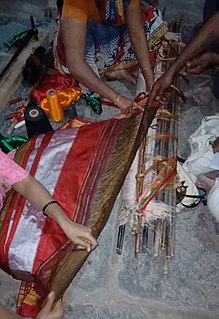 W
WIlkal sari is a traditional form of sari which is a common feminine wear in India. Ilkal sari takes its name from the town of Ilkal in the Bagalkot district of Karnataka state, India. Ilkal saris are woven using cotton warp on the body and art silk warp for border and art silk warp for pallu portion of the sari. In some cases instead of art silk, pure silk is also used. Ilkal sari has been accorded geographical indication (GI) tag. Its GI tag number is 76.
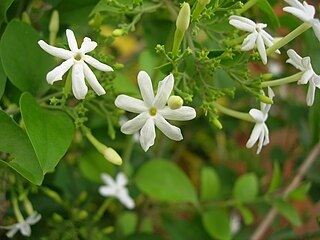 W
WJasmine is considered the queen of flowers and is called the "Belle of India" or the "Queen of fragrance" as it is exquisitely scented to soothe and refresh. In different parts of India it is called by different names—Mogra, Motia, Chameli, Malli puvvu, Jaati, Mallige, Juhi, Mogra or Moonlight in the grove. It is reported that there are 300 varieties of jasmine. It is also stated that jasmine crossed the seas—from Asia to Europe, landing first along the Mediterranean Sea, conquering Greece and Turkey, reaching Western Europe through Spain, then France and Italy and finally landing in England in the latter part of the 17th century..
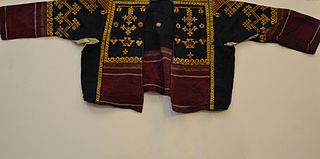 W
WKasuti is a traditional form of folk embroidery practised in the state of Karnataka, India. Kasuti work which is very intricate sometimes involves putting up to 5,000 stitches by hand and is traditionally made on dresswear like Ilkal sarees, Ravike and Angi or Kurta. The Karnataka Handicrafts Development Corporation (KHDC) holds a geographical indications (GI) protection for Kasuti embroidery which provides intellectual property rights on Kasuti to KHDC.
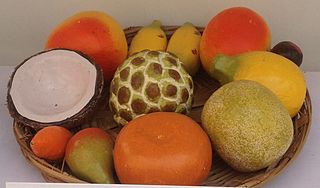 W
WKinnal Craft or Kinhal Craft, is a traditional wooden craft local to the town of Kinhal, or Kinnal, in Koppal District, North Karnataka, India.
 W
WMangalore Buns is a popular breakfast or tea time snacks in the Udupi-Mangalore region of Karnataka, India. This food belongs to Tulu Mangalorean cuisine or Udupi cuisine. The buns are mild sweet, soft fluffy puris made using all purpose flour and banana. These buns are also called as banana buns or pooris. Typically served with a spicy coconut chutney and sambar, but they also taste great without any accompaniment. They're known for their deliciousness.
 W
WMangalore tiles are a type of tile native to the city of Mangalore, India. Typically considered to be a part of Spanish and Italian architectural styles, the tiles were first introduced to India in 1860 by a German missionary. Since that time, the industry has flourished in India with these red tiles, prepared from hard laterite clay, in great demand throughout the country. They are exported to Myanmar, Sri Lanka, and the Far East and even as far as East Africa, the Middle East, Europe, and Australia. These were the only tiles recommended for government buildings in India under the British Raj.
 W
WMonsooned Malabar, also known as Monsoon Malabar, is a process applied to coffee beans. The harvested coffee seeds are exposed to the monsoon rain and winds for a period of about three to four months, causing the beans to swell and lose the original acidity, resulting in a flavor profile with a practically neutral pH balance. The coffee is unique to the Malabar Coast of Karnataka, Kerala and the Nilgri mountains of Tamil Nadu and has protected status under India's Geographical Indications of Goods Act. The name Monsoon Malabar is derived from exposure to the monsoon winds of the Malabar coast.
 W
WMysore Agarbathi is a variety of incense sticks manufactured at Mysore using locally grown ingredients which was found only in state of Karnataka before. This incense has been awarded Geographical Indication tag from the Government of India in 2005 due to its historic background and remote availability of material used. Aptly, Mysore is also home to the world's largest manufacturer of agarbathi - N. Ranga Rao & Sons popularly known for the Cycle Pure Agarbathies.
 W
WMysore betel leaf is a variety of heart shaped betel leaf grown in and around the region of Mysore. It is consumed as a betel quid or as paan, with or without tobacco. A sheaf of betel leaves is traditionally offered as a mark of respect and auspicious beginnings. Areca nut are kept on top of the sheaf of betel leaves and offered to the elders for their blessings and during wedding ceremonies.
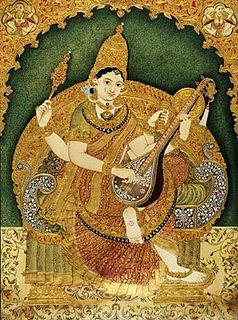 W
WMysore painting is an important form of classical South Indian painting that originated in and around the town of Mysore in Karnataka encouraged and nurtured by the Mysore rulers. Painting in Karnataka has a long and illustrious history, tracing its origins back to the Ajanta times The distinct school of Mysore painting evolved from the paintings of Vijayanagar times during the reign of the Vijayanagar Kings The rulers of Vijayanagar and their feudatories encouraged literature, art, architecture, religious and philosophical discussions. With the fall of the Vijayanagar empire after the Battle of Talikota the artists who were till then under royal patronage migrated to various other places like Mysore, Tanjore, Surpur, etc. Absorbing the local artistic traditions and customs, the erstwhile Vijayanagar School of Painting gradually evolved into the many styles of painting in South India, including the Mysore and Tanjore schools of painting.
 W
WMysore pak is an Indian sweet prepared in ghee. It originated in the city of Mysuru, one of the major cities in the Indian state of Karnataka. It is made of generous amounts of ghee, sugar, gram flour, and often cardamom. The texture of this sweet is similar to a buttery and dense cookie.
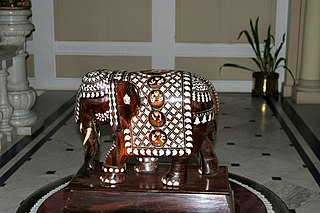 W
WMysore Rosewood Inlay covers a range of techniques used by artisans in around the area of Mysore in sculpture and the decorative for inserting pieces of contrasting, often coloured materials like ivory shells, mother-of-pearl, horn and sandalwood into depressions in a rosewood object to form ornament or pictures that normally are flush with the matrix. These artifacts are manufactured in around the region of Mysore, these artifacts have been awarded Geographical Indication tag from the Government of India in 2005 due to its historic representation as an artifact depicting the region and the design and style used by the local artisans
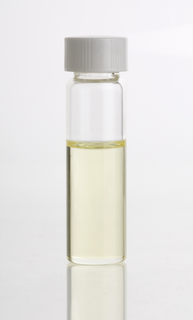 W
WMysore Sandalwood Oil is a trademarked perfume oil extracted from the Santalum album variety of sandalwood tree in the Mysore district of Karnataka, India. The tree species is said to be one of the best varieties in the world.
 W
WKarnataka produces 9,000 metric tons of mulberry silk of a total of 20,000 metric tons of mulberry silk produced in the country, thus contributing to nearly 45% of the country's total mulberry silk. In Karnataka, silk is mainly produced in the Mysore district. It is a patent registered product under KSIC. KSIC is an owner of the Mysore Silk brand.
 W
WThe Nanjangud banana, natively called as Nanjangud rasabalehannu, is a variety of banana grown in and around the area Mysore district and Chamarajanagar district of Karnataka, India. It is famous for its unique taste and aroma. It was found that the black clay alluvial saline soil found in and around Nanjangud drastically changed the taste and aroma, giving it a particular geographical identity, so it is now registered under geographical indicators under Government of India.
 W
WUdupi Mattu Gulla, or Udupi Matti Gulla, is a variety of green brinjal grown in and around the village of Matti in Udupi, India. It was given the Geographical Indication tag in 2011.